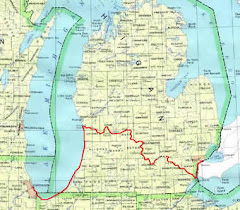My "Seagull" flew down the length of Little River. The upper part doesn't look like it would float a canoe but lower down there appears to be plenty of water. When it reaches Huntington there are two small dams. A couple miles west of town the Little, which appears relatively clear, flows into the colored Wabash. This confluence is a few miles downstream of a dam that holds back Huntington Lake.
.Wikipedia: "The Wabash River is a 475-mile long river...that flows southwest from northwest Ohio...across northern Indiana to Illinois where it forms the southern Illinois-Indiana border before draining into the Ohio River, of which it is the largest northern tributary. From the dam near Huntington to its southern terminus at the Ohio River, the Wabash flows freely for 411 miles which makes it the longest stretch of free-flowing river east of the Mississippi...
When the Wisconsin Glacier melted 14,000 years ago, part of the meltwaters formed the pro-glacial Lake Maumee, the ancestor to Lake Erie. Eventually the meltwater overtopped a glacial moraine located near Fort Wayne, Indiana, and catastrophically drained southwestward in the Maumee Torrent. The torrent carved the wide alluvial valley that the Wabash flows through today."
Verlen's words: "The morning after Christmas (1986) we put our canoes into the Wabash River near Huntington...sixteen other canoes joined us for a few hours...The canoeists were not the usual fair weather paddlers...On the upper Wabash, there are a number of small rapids and fast water spots that pushed into "sweepers" (fallen trees). We hadn't gone a mile before an aluminum canoe misjudged and got swept into a sweeper, flipped and got trapped in partially submerged branches. It took us nearly a half hour with ropes and many helping hands to get the canoe free. The paddlers only got wet. Sweepers in fast water, especially on bends of the river are probably the worst and trickiest hazards on a small river. It is easy to misjudge the force of the water pushing your canoe where you don't want it to go. I have learned the hard way to treat sweepers with respect - to give them a wide berth and to keep my seat low."
"Seagulling" down the river near Largo, about the second town after Huntington, you find a most unusual geological phenomenon, "Hanging Rock" National Monument, a huge limestone cliff towering about 90' above the river's left bank and leaning over the river. Nothing around it but flat Indiana farm land. I can't imagine how or why the glacier didn't grind it down.
Continuing down the river you reach Wabash, Peru and then Logansport with the Eel River coming in from the right. All along roads, usually US 24, follow along the right bank where the Wabash and Erie Canal used to be.
A few miles upstream of Lafayette and West Lafayette the Tippecanoe River comes in from the north. This was the site of the Battle of Tippecanoe
Wikipedia: "The battle of Tippecanoe was fought on November 7, 1811, between United States forces led by Governor William Henry Harrison of the Indiana Territory and the forces of Tecumseh's growing American Indian confederation led by his brother, Tenskwatawa...The battle took place outside Prophetstown, at the confluence of the Tippecanoe and Wabash Rivers...Although the Americans were victorious...the win was costly as the tribes attacked with fewer men and sustained fewer casualties...Tippecanoe dealt a devastating blow to Tecumseh's confederacy, which never regained its former strength." You should read the rest of the Wikipedia article.
Neither Verlen nor Valerie mentioned the place or the battle, but I can't imagine that they didn't look over the battlefield which is located right by the river.
Next downstream is Lafayette and west Lafayette, the home of Purdue University.
I took a circle over Purdue's football field, Ross-Aide Stadium, I felt like I was in the Goodyear blimp on a fall big-game saturday afternoon.
Valerie: "I am discovering that miracles do happen. When we left Lafayette, traveleing downstream on the Wabash, I saw a movement on shore...and saw a bird thrashing in the mud. Verlen and I both paddled over - it was a hawk caught in a muskrat trap! Verlen carefully got out of his boat and poked the terrified bird with his paddle. The bird didn't peck or bite at the blade so Verlen felt safe enough to kneel down and work the trap until the bird was free. With no hesitation the bird flew into the air. I thought a long time about the fate of that bird..."
Next: More on the Wabash


No comments:
Post a Comment